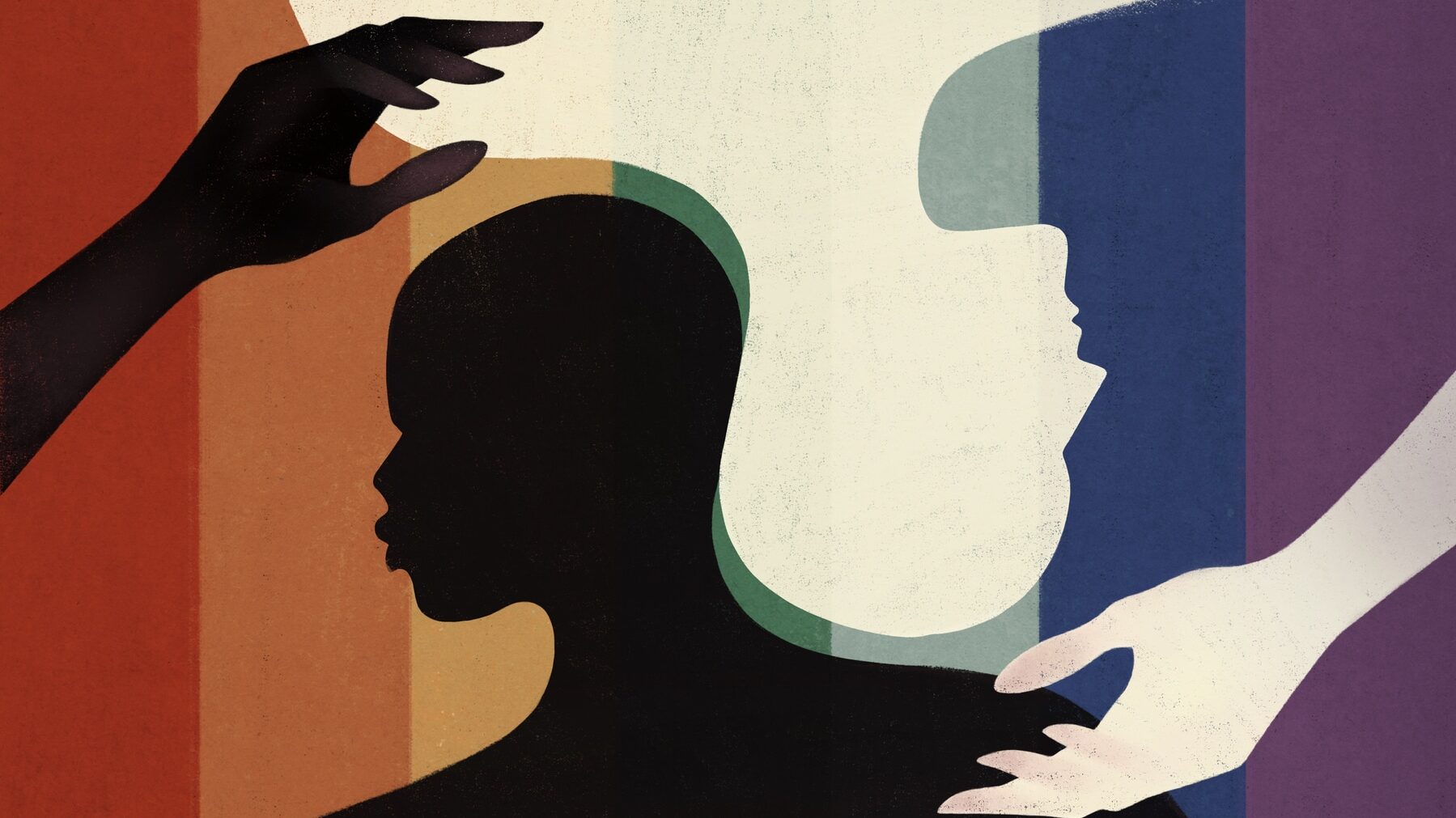
Society is slowly becoming more accepting of people who identify as transgender or gender diverse, but violence and stigma against this community continue. A number of anti-transgender health care bills, gag orders on education about gender identity and sexuality, and bans on trans athletes, public accommodations, and drag have been proposed or passed in recent months. Due to stigma and discrimination, transgender people have higher rates of victimization, STDs/HIV, mental health issues, and suicide, and are less likely to have health insurance than cisgender people. It can be hard to not internalize transgender rejection and stigmatization, which can fuel feelings of unease with gender identity, known as gender dysphoria.
What is gender dysphoria?
People who experience gender dysphoria don’t identify with the sex they were assigned at birth and experience significant distress as a result. They may want different primary and secondary sex characteristics and wish to be treated like another gender. For example, a person born with male sex characteristics may mentally, emotionally, and psychologically identify as a woman. This can cause internal conflict because their gender identity doesn’t match the one that society expects and accepts based on their physical anatomy.
“It’s important to understand that the terms transgender and gender dysphoria aren’t interchangeable. Not all transgender people experience dysphoria,” said Keren Lehavot, PhD, Lyra Health’s senior clinical training lead of culturally responsive care. “The distress associated with gender dysphoria is largely tied to societal, relational, and cultural factors that signal gender identity should be binary and based on biology.”
Terms related to gender dysphoria
When answering the question, “What is gender dysphoria,” it’s important to understand the terms used to describe gender that are continually evolving to become more inclusive, descriptive, and reflective of gender experiences and expression. Knowing some key terms can give context to discussions about gender dysphoria.
Gender
The behavioral, cultural, or psychological traits that society associates with male and female sexes.
Sex assigned at birth
A designation of assigned male at birth (AMAB) or assigned female at birth (AFAB) based on internal reproductive organs, external genitalia, and sex chromosomes. Gender and sex are not the same.
Gender identity
The mental and psychological experience of being a boy/man, girl/woman, both, none, or something else, regardless of the sex assigned at birth.
Transgender
An umbrella term for people whose gender identity doesn’t align with the sex they were assigned at birth. The term includes people who have or haven’t used medical interventions to transition to the opposite sex as well as people who don’t identify as either male or female, both male and female, gender queer, and other identities. Transgender people may be gay, straight, bisexual, or another sexual orientation, and this orientation may or may not change after transitioning.
Gender expression
The outward expression of gender, which may include how people dress, carry themselves, speak, and accessorize.
Gender diverse
An umbrella term for fluid gender(s) expressions, identities, and perceptions that don’t conform to stereotypes and societal norms.
Cisgender
People who identify with the sex assigned to them at birth.
Binary
The classification of gender as only male or female based on social systems and cultural beliefs.
Nonbinary
A term used to describe someone whose gender identity is not exclusively boy or man or girl or woman.
Sexual orientation
The types of people an individual is attracted to emotionally, physically, and romantically.
Gender dysphoria symptoms
People who experience gender dysphoria may feel like there’s a mismatch between their physical and mental selves. Strong societal messages that they should identify with the gender they’re assigned at birth can cause an internal battle and struggle to accept themselves. The Diagnostic and Statistical Manual of Mental Disorders (DSM-5-TR) defines gender dysphoria as a marked incongruence between a person’s expressed or natal gender for at least six months that impairs functioning in social, occupational, and other areas as experienced by at least two of the following:
- Significant incongruence between experienced gender and primary or secondary sex characteristics or expected sex characteristics (in young adolescents)
- Strong longing to have sex characteristics of the other gender
- Substantial desire to get rid of or stop the development of primary and/or secondary sex characteristics because of distress from the experienced versus outward expression of sex characteristics
- Strong desire to be the other gender or an alternative gender
- Strong desire to be treated as the other gender or an alternative gender
- Conviction that one’s reactions and feelings are typically of the other gender or alternative genders
What causes gender dysphoria?
Gender identity development is complex and there aren’t yet clear answers on what causes gender dysphoria. “There’s likely a part tied to societal response and the level of acceptance an individual receives from parents and loved ones about their gender identity,” said Lehavot. “Seeing the backlash of harmful policies and laws that affect transgender rights as well as experiencing rejection may fuel distress associated with gender dysphoria.”
Misconceptions about gender identity
Some of the reasons for gender dysphoria stem from traditional beliefs so deeply rooted in society and culture that many people have no point of reference for transgender and gender-diverse gender identities.
Common misconceptions about gender identity include the following.
Myth 1: Being transgender is a mental health disorder
Being transgender is not a psychiatric disorder. Gender dysphoria, which is marked by significant distress, is classified in the DSM-5. The hope is that the term gender dysphoria highlights the identity stress people experience that may lead them to seek mental health care. A gender dysphoria diagnosis can help trans people access necessary and effective health care. It’s important to note that conversion therapy (to attempt to make a person cisgender) is a non-effective and harmful practice. The appropriate care for a gender dysphoria diagnosis is gender-affirming care.
Myth 2: Being transgender or gender diverse is an intentional choice
Having a transgender or gender-diverse identity is not a decision someone just makes one day. “Gender lives in the mind, and gender identity is very hard to define. Being transgender is not a ploy to get attention or be part of a trend. It’s an internal feeling of who you are,” said Lehavot.
Myth 3: People who are transgender just want attention
Being transgender is not a trend. Research shows that there have been no leaps in numbers of transgender people. Teens aren’t gaining social status by coming out as transgender. Bullying and suicide rates are still much higher among transgender youth than cisgender youth.
Myth 4: Children aren’t old enough to know they’re transgender
It’s very possible for young children to know their gender identity. “People’s sense of their gender starts around age 3,” said Lehavot. “It develops regardless of traditional expressions or identities aligned with sex characteristics.” Trans and gender-diverse children are typically consistent, insistent, and persistent with regards to their gender identity. Those who socially transition at early ages typically continue to identify that way years later. It’s imperative that parents support their children’s gender identity. Attempting to steer kids toward a different gender identity can have devastating consequences. LGBTQIA+ children whose families are inconsistent with support or don’t support their gender identity are at significant risk for mental health disorders, substance misuse, and suicide attempts later in life. “It’s important for parents to be supportive of their children, provide them a safe space, and reach out for additional support,” said Lehavot. There are several resources available to help parents discuss gender identity and find professional support.
Myth 5: Gender identity and sexual orientation are linked
Sexual orientation and gender identity are independent parts of a person’s identity. Gender identity is the psychological and mental experience of gender. Sexual orientation is a romantic and physical attraction to someone.
Myth 6: All transgender people want medical interventions to change their physical characteristics
Gender-affirming medical care may include hormone blockers, hormones, and an array of different surgeries. Only one in four transgender and nonbinary people choose to have gender-affirming surgery. It’s important not to make assumptions about someone’s gender identity based on their appearance, or what medical interventions they may or may not want.
What is treatment for gender dysphoria like?
Treatment for gender dysphoria typically includes therapy and in some cases medical interventions depending on the individual’s goals and age. Gender-affirming surgery for people under 18 is illegal in most states. Children and adolescents experiencing gender dysphoria have the additional concern of puberty. Puberty blockers can be considered that will stop testosterone-and estrogen-related changes like breast development, menstruation, facial hair, and voice changes. Individual, family, and group therapy can help children and teens explore gender preferences. Adults can pursue surgical treatments for gender dysphoria, as well as medications and therapy.
Therapy can provide a safe, non-judgmental space to help transgender people address mental health issues like depression or anxiety and support their journey to self-acceptance. It‘s meant to destigmatize transgender identity, not “fix” discomfort by changing gender to the one assigned at birth.
“There may be lots of transition issues to explore in therapy as well,” said Lehavot. “For example, how the individual wants to dress and present socially, coming out to family and loved ones, managing relationships, and improving self-esteem.”
The World Professional Association for Transgender Health (WPATH) developed clinical guidelines for standards of care and best practices in health care for transgender and gender-diverse people based on the latest science and expert professional consensus. These guidelines include themes around affirmative approaches that acknowledge, validate, and respect gender identity as well as recommendations for topics like medical interventions to change sex characteristics. Some ways professionals can support and care for gender-diverse people in culturally responsive ways include:
- Educating clients on options for medical interventions like feminizing hormone therapy and surgery, masculinizing hormone therapy and surgery, and puberty blockers
- Discussing different gender identities and gender expressions
- Supporting clients as they clarify and explore gender identity and role
- Openly acknowledging and apologizing for errors like using the wrong pronouns and processing the mistake with clients
- Diagnosing and treating co-occurring disorders like anxiety or depression
- If the client desires, assessing eligibility for hormone therapy and/or surgery and referring them to appropriate health care professionals
- Informing clients about peer support groups and education and advocacy opportunities
- Acknowledging and addressing the impact of stigma, and societal rejection and discrimination on gender diverse people
- Identifying ways to maximize client self-care and well-being
- Examining their own knowledge, attitudes, and beliefs about gender identity and expression
- Educating themselves on transgender health care issues, discrimination, and political and advocacy topics
- Consulting with transgender experts and professionals
- Staying relaxed, curious, and mindful of body language
“It’s also important to acknowledge the strengths related to trans identity for a client,” said Lehavot. “We often overlook these really incredible positives like the pride and bravery of tapping into their identity and being their authentic selves.”
How people with gender dysphoria can help themselves
Gender dysphoria can often feel isolating and overwhelming, but there are several ways to gain help and hope.
Seek gender-affirming care
Search for medical and behavioral health providers who practice gender-affirming care. Some will note this in online profiles. If they don’t, call and ask. “Look for medical facilities and other community resources that outwardly state they provide gender-affirming care or serve people who are transgender,” said Lehavot. “The trans community is also very active in this space and can provide referrals to gender-affirming health care providers.”
Join a support group
Peer support groups are useful for sharing and validating experiences, which helps people feel less isolated. “Community support is huge in optimizing trans mental health,” said Lehavot. “Even if there’s just one supportive person, it can really make a big difference.” Depending on someone’s specific living situation or journey, in-person outreach can feel unsafe. Online support groups and virtual transgender communities can feel more safe in these instances.
Prioritize self-care
People with gender dysphoria can engage in self-care to help them feel good about themselves and their bodies. Things like getting enough sleep, exercising, eating healthy food, and participating in hobbies are important to overall well-being and are also acts of self-love.
Affirm your identity
Expressing gender identity in clothing or accessories, or asserting pronouns can build confidence and nurture self-acceptance.
Explore gender-affirming hormones or surgery, if desired
Medical interventions like hormone therapy and gender-affirming surgery can make some transgender people more comfortable in their bodies. Research finds that gender-affirming medical interventions can increase well-being and lower the risk of depression and suicidality in transgender and nonbinary youth. This decision is highly personal and only the individual can know if it’s right for them. Some transgender people alter their appearance through measures like breast binding, genital tucking, or hair removal.
Advocate for your community
There are endless opportunities to advocate for equality for transgender and gender diverse people. Getting involved can feel empowering for some, knowing they’re working toward dismantling barriers for others.
“Activism and advocacy in the current climate might feel good for some, but for others it may feel like just one more thing they need to do that’s draining their energy,” said Lehavot. “And it’s OK not to participate if that’s your experience.”
Find safe spaces
“It’s helpful to identify culturally safe spaces like support groups or LGBTQIA+ meetups or events that are accepting and limit exposure to places that feel stigmatizing or increase stress levels,” said Lehavot. “This can include people and places as well as taking actions like limiting time spent on social media or following news.”
Celebrate with your community
Connecting with others in ways that highlight the strength and accomplishments of the transgender community can be healing. “Opportunities like Pride Month help us really claim transgender joy and the positive aspects of this identity and community, which is critical in this difficult cultural climate,” said Lehavot.
Support is here
There’s no downplaying the very real political and societal stressors facing the transgender community right now, but there’s a community of professionals, peers, allies, and advocates ready to embrace you, support you, and stand with you as your true, genuine, amazing self.
Support is available for gender dysphoria.
You can get started today if your employer offers Lyra.
Sign up nowPrioritize your emotional well‑being.
Join Lyra today

